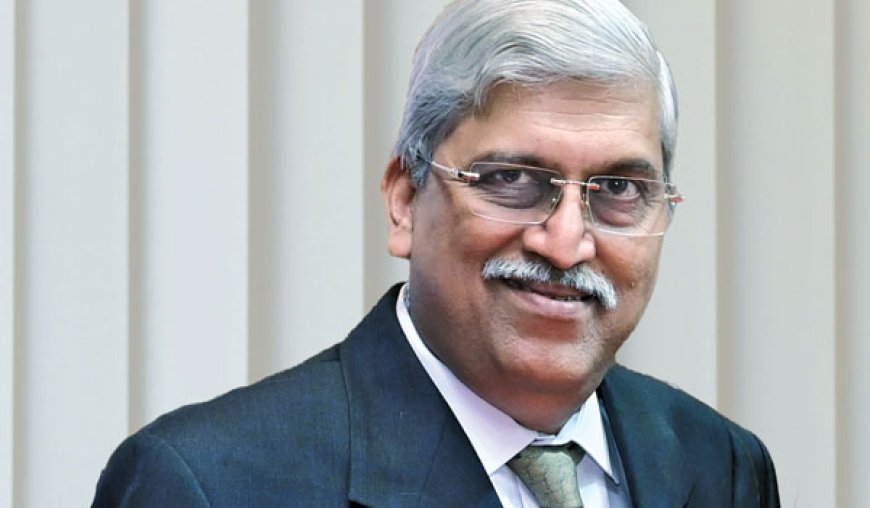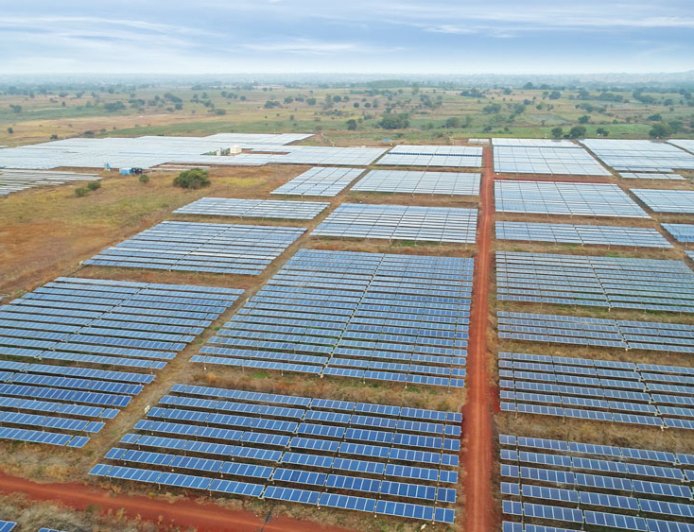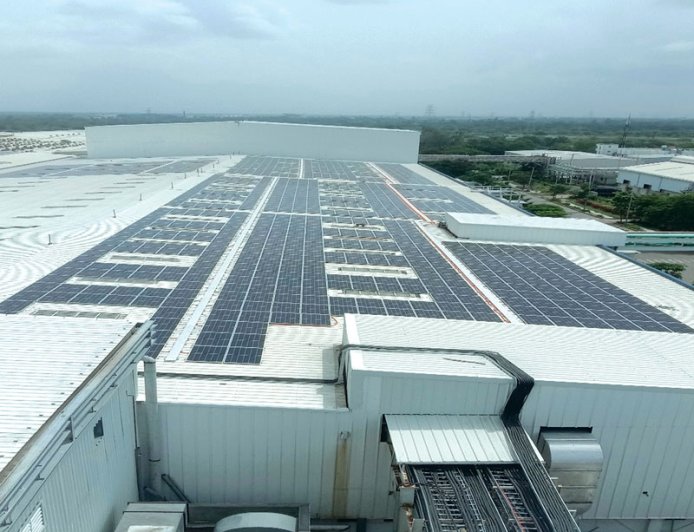While the opportunities are substantial, navigating the challenges effectively is crucial to capitalizing on them.

Vimal Kejriwal
MD & CEO, KEC International Limited
What are the prevailing trends in solar energy segment? How do government policies support the segment?
From FY18 to FY24, India has witnessed remarkable capacity growth, with solar installations increasing from 22 GW to 90 GW, now accounting for 45% of the total renewable energy capacity of 200 GW. This growth is complemented by a significant decline in the costs of solar PV technology, making both utility-scale and decentralized solutions like rooftop and microgrid systems more accessible. Solar is not a ‘good to have’ source of energy anymore. Market now demands reduced base load intermittency and increased quality of power. Hybrid and storage solutions are becoming increasingly essential to address the intermittent nature of renewable energy. RTC (Round-the-Clock) and FDRE (Flexible Dispatchable Renewable Energy) tenders are emerging as key solutions to this intermittency, with FDRE likely to replace standalone renewable energy tenders soon. The push for green hydrogen is another major trend, driving new solar installations as it aligns with India’s decarbonization goals. The production of green hydrogen relies heavily on renewable energy sources, particularly solar and wind, further boosting solar capacity.
 Government policies play a crucial role in supporting these trends. There are policies both in demand and supply side, providing a 360-degree push for renewables energy. In the demand side, we have Renewable Purchase Obligation (RPO) that mandates utilities to source a portion of their energy from renewables, incentivizing solar adoption. FDRE and RTC too push the adoption from demand end. Open access policies allow industries to purchase solar power directly, promoting renewable energy adoption. From supply standpoint, the Production-Linked Incentive (PLI) scheme promotes domestic manufacturing of high-efficiency solar modules with a significant outlay. The PM Kusum scheme encourages decentralized solar installations to reduce farmers' dependence on diesel. India is also focusing on developing solar parks and Ultra Mega Solar Power Plants to streamline land acquisition and regulatory approvals. Additionally, the imposition of Basic Customs Duty (BCD) on solar imports aims to bolster domestic production, while waivers on transmission charges encourage the establishment of renewable energy projects.
Government policies play a crucial role in supporting these trends. There are policies both in demand and supply side, providing a 360-degree push for renewables energy. In the demand side, we have Renewable Purchase Obligation (RPO) that mandates utilities to source a portion of their energy from renewables, incentivizing solar adoption. FDRE and RTC too push the adoption from demand end. Open access policies allow industries to purchase solar power directly, promoting renewable energy adoption. From supply standpoint, the Production-Linked Incentive (PLI) scheme promotes domestic manufacturing of high-efficiency solar modules with a significant outlay. The PM Kusum scheme encourages decentralized solar installations to reduce farmers' dependence on diesel. India is also focusing on developing solar parks and Ultra Mega Solar Power Plants to streamline land acquisition and regulatory approvals. Additionally, the imposition of Basic Customs Duty (BCD) on solar imports aims to bolster domestic production, while waivers on transmission charges encourage the establishment of renewable energy projects.
What are the emerging opportunities for you in solar segment with more capacity addition on anvil?
I see several emerging opportunities in the solar segment, especially with the significant capacity additions on the horizon.
First, hybrid projects are gaining traction. Combining solar with other renewable sources such as wind allows for more stable and reliable energy generation, which is essential for meeting growing demands.
Additionally, integrating solar with Battery Energy Storage Systems (BESS) is a game-changer. It enhances energy management and provides grid stability, making it the need of hour. Market is looking at 2-6 hours battery storages now which will move to 12 hours soon. Floating solar installations are also gaining popularity and we are studying the market.
I also believe there's a vast untapped market within the commercial and industrial (C&I) sector. Just like RPG Group, many businesses are now prioritizing sustainability and energy efficiency, presenting us with a unique opportunity to provide tailored solar solutions.
And last but not the least, international markets, particularly in the Middle East and East Africa, are ripe for exploration. These regions are investing heavily in renewable energy, and our expertise can help facilitate their transition to solar power.
How do you look at the input cost challenges in solar projects?
Firstly, solar modules are a significant cost driver, accounting for about 60% of the total project cost. While we’ve seen a decline in module prices recently, they remain volatile due to global supply and demand imbalances. India is still a module assembler, and we are dependent on the PV cells and wafers. This uncertainty poses challenges for long-term project planning and profitability. A solution lies in providing a price-variation formula for modules.
In addition to module costs, commodity prices—such as copper, aluminium, and steel—affect approximately 15-20% of the total project expenses. Fluctuations in these markets can directly impact our margins, making it essential to closely monitor and manage these costs.
 Another pressing issue is labour. The solar sector’s rapid expansion has created a strong demand for skilled labour, making recruitment and retention increasingly challenging. This growing demand leads to rising labour costs and project delays, which can strain project budgets if not managed effectively. Additionally, the key skill-gap issue is to manage the grid. It should also be noted that RE capacity expansion is fruitful only if the grid is managed well as electricity from multiple sources come in at different time periods in a day. The complexity will increase as the rooftop solar program gets traction. Moreover, right-of-way (ROW) and land settlement costs can be particularly unpredictable. The complexities involved in securing land can lead to unexpected expenses and delays.
Another pressing issue is labour. The solar sector’s rapid expansion has created a strong demand for skilled labour, making recruitment and retention increasingly challenging. This growing demand leads to rising labour costs and project delays, which can strain project budgets if not managed effectively. Additionally, the key skill-gap issue is to manage the grid. It should also be noted that RE capacity expansion is fruitful only if the grid is managed well as electricity from multiple sources come in at different time periods in a day. The complexity will increase as the rooftop solar program gets traction. Moreover, right-of-way (ROW) and land settlement costs can be particularly unpredictable. The complexities involved in securing land can lead to unexpected expenses and delays.
Additionally, there is a huge scope of improvement for fund velocity. The same money instead of being invested for seven years could be invested for three years. Utilizing green bond markets or pension funds is also a viable option.
Lastly, our organization is committed to sustainability. While we strive to minimize land use impacts, utilize eco-friendly construction practices, and promote biodiversity conservation, these initiatives can introduce additional costs. However, I believe that investing in sustainability not only benefits the environment, but also enhances our long-term viability in the market.
Overall, navigating these input cost challenges requires a strategic approach and proactive risk management.
Can you give us an overview on your solar energy capacity?
I'm proud to share that our company has made significant strides in solar energy capacity in short time, contributing to India’s renewable energy goals. At present, we are executing two major projects that collectively add up to 1.2 GW of solar capacity in Karnataka and Rajasthan. We have already executed and commissioned 500 MW+ projects in the past.

These projects not only reflect our rapid expansion in the sector, but also highlight our dedication to meeting sustainability goals. As we move forward, we remain focused on enhancing our solar portfolio while supporting the transition to renewable energy in India and beyond.
What are your expansion plans in line with the country’s RE capacity enhancements?
Our expansion plans are aggressive, focusing exclusively on solar, wind, and green hydrogen. In solar, we categorize the total addressable market based on whether clients supply the modules or we do. For client-supplied modules, we are already executing two projects totaling over 1.2 GW. This demonstrates our cost leadership and the trust clients place in our execution. For projects where we supply the modules, we are actively seeking partnerships with module vendors.
 In addition to solar, we recognize the critical need for wind energy and storage. wind is essential for the success of RTC and FDRE systems. The wind EPC market is fragmented and dominated by local unorganized players, presenting us with a significant opportunity to become the preferred EPC contractor. Our extensive experience in heavy lifting and foundation work makes us a natural fit for wind projects, and we hope to secure a project by the end of FY25. Green hydrogen is another area of interest for us. While there are numerous pilot projects, the lack of off-takers has made large-scale projects moonshot as of now. We are also exploring battery storage and pumped storage, planning to enter the market as an EPC player when conditions are favourable.
In addition to solar, we recognize the critical need for wind energy and storage. wind is essential for the success of RTC and FDRE systems. The wind EPC market is fragmented and dominated by local unorganized players, presenting us with a significant opportunity to become the preferred EPC contractor. Our extensive experience in heavy lifting and foundation work makes us a natural fit for wind projects, and we hope to secure a project by the end of FY25. Green hydrogen is another area of interest for us. While there are numerous pilot projects, the lack of off-takers has made large-scale projects moonshot as of now. We are also exploring battery storage and pumped storage, planning to enter the market as an EPC player when conditions are favourable.
How do you look at the future market opportunities for renewable energy?
The future of solar energy and renewables is undeniably bright, but I believe it’s essential to recognize the complexities involved. As an EPC player, we need to approach the market with careful analysis and caution. On the positive side, we have ambitious installation targets for solar modules and supportive government policies that are driving growth. Attractive tariff rates promise solid returns for investors, and there’s a significant push to develop the domestic manufacturing market. I also envisage exciting opportunities in the growing energy exchange market and the increasing focus on green hydrogen and battery storage, where Solar will be the primary driver.
However, we must also be aware of the challenges, such as land acquisition issues and the ongoing struggles with grid connectivity for power evacuation. Additionally, our reliance on external manufacturing can pose risks. All these challenges can have cascading impact on time and cost.
Overall, while the opportunities are substantial, navigating these challenges effectively is crucial to capitalizing on them. At the end of the day, our duty is to maximize returns for our shareholders and investors.







